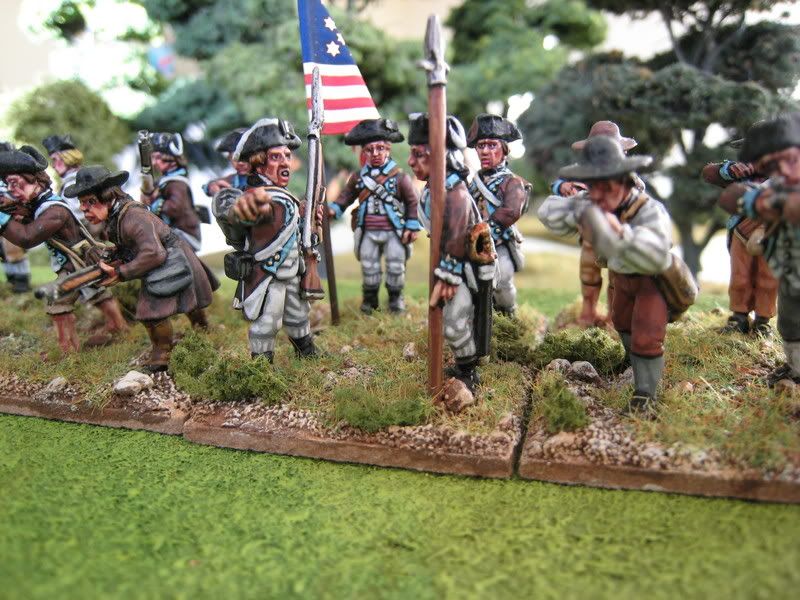
Like many gamers, I imagine, I like to listen to music whilst I paint figures. Usually I put on whatever's close to hand, but last week I started thinking about what music would have been familiar to British concert-goers at the time of the AWI. Contrary to popular belief (and those who think that British music began with the Beatles), Britain in the latter half of the 18th century was one of the must musical countries in Europe, having an abundance of home-grown talent and a vibrant concert scene which enticed established composers and performers from the Continent to visit and, in some cases (such as Handel, JC Bach and Haydn), to remain in the country for prolonged periods. As well as London, regional capitals such as Bath, Coventry and Manchester were home to flourishing musical activities.
So what music would Messrs. Clinton, Cornwallis, Howe and Burgoyne have had on their iPods and what would George III have played on his harpsichord? I have delved deep into my cd collection and put together a Top Ten of the era's greatest musical hits. All the music below has been recorded on the Hyperion Records label.
1. George Frideric Handel: "Judas Maccabeus". Handel was George III's favourite composer, since he grew up surrounded by his music (often quite literally). Handel died in 1759 but George's admiration for his music helped ensure that it continued to be regularly performed. Military men would have enjoyed the oratorio "Judas Maccabeus", written in 1747 to celebrate the defeat of Bonnie Prince Charlie and which features the stirring chorus "See, the Conqu'ring hero comes".
2. Thomas Linley: "The Tempest". Thomas Linley the younger was a prodigy, whose death in 1778 at the age of only 22 was a tragedy for English music. Mozart called him a "true genius". His works include incidental music for a production of Shakespeare's "The Tempest" at the Theatre Royal in Drury Lane in 1777. General John Burgoyne wrote plays that probably had incidental music and consequently he may have known of Linley.
3. Samuel Wesley: Violin Concerto in D Major. The Methodist Wesley family arranged concerts at their family house in Marylebone and Samuel (1766-1837, son of the famous writer of hymns) composed seven violin concertos for those events between 1779 and 1785. His D Major concerto dates from 1781; its sunny disposition belies the events unfolding at Yorktown.
4. Thomas Arne: Concerto No3. in A Major. This list would not be complete without some music by Thomas Arne (1710-87), the composer of "Rule Britannia". Arne wrote 6 concertos and much other music for keyboard and George III, a keen harpsichord player, would have known his work. This concerto was written in the late 1770s for the new "piano e forte". Pianos became common in London in the 1770s and composers were eager to write or revise works for this new instrument.
5. Joseph Haydn: Symphony No.70. Haydn stayed in London during 1791/2 and 1794/5 and during the latter visit penned his well-known "Military" and "Drumroll" Symphonies (numbers 100 and 103 respectively). I'm sure our AWI generals would have enjoyed the vigour of those works. Haydn's Symphony No.70 is not as well known but just as fiery. It dates from 1779.
6. Joseph Key: "As shepherds watched their fleecy care". People went to church regularly in those days and Key's setting of a favourite Christmas theme (dating from the early 1780s) was one of the most popular carols in the Georgian repertory.
7. JC Bach: "Farewell to Lochaber": Johann Christian Bach, son of JS Bach, settled in London in 1762. He became Music Master to Queen Charlotte and gave her singing lessons. Whilst the evocation of Scotland may have been a bit too Jacobite for the Royal Household's liking, Bach's arrangement of the folk-song "Farewell to Lochaber" was a hit with London audiences during the 1770s.
8. Carl Friedrich Abel: Quartet in A Major. Abel was another of Queen Charlotte's chamber musicians, who arrived in London in 1758 and remained there until his death thirty years later. His A Major string quartet was part of a set (Op.8) that was published in 1769. These were among the first string quartets to be published in England, and one can imagine George III, who played the violin as well as the flute and harpsichord, being delighted at a court composer producing works in a novel form that the king himself could try out.
9. William Jackson: "Love in thine eyes for ever plays". This beautiful song, composed for two sopranos, cello and harpsichord, is the sort of thing that Mr and Mrs King might have played together in Buckingham House with JC Bach and other household musicians. It was published in 1782. Jackson would then have fallen out of favour with George as he condemned the extravagent Handel Commemorations of the later 1780s as showing exaggerated veneration of the composer, to the detriment of contemporary "local" composers.
10. Anonymous: "The British Grenadiers". Surely one of the best marching songs ever written (this post's title is the beginning of the first line), its origins are lost in the mists of time but the tune itself is thought to have been written in the 1600s. The march is noted as having been played by the British army at the Battle of Brandywine in 1777. Hyperion have recorded an arrangement for tenor solo, chorus and small orchestra which dates from about 1770.
















































